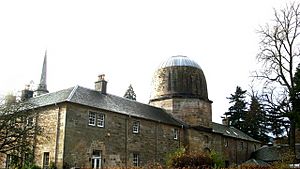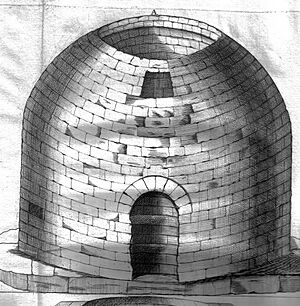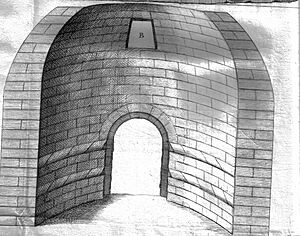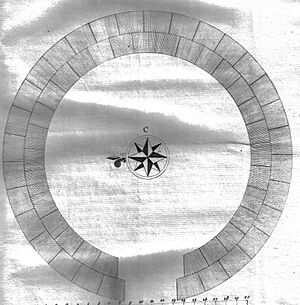Arthur's O'on facts for kids
Arthur's O'on (which means "Oven" in Scots) was a very old building, probably a Roman temple. It stood near the River Carron in Stenhousemuir, Scotland, until 1743. Many people believe this building was the "stone house" that gave Stenhousemuir its name.
Even hundreds of years ago, people were curious about Arthur's O'on. They wondered about its history and the myths connected to it. By the year 1200, the land where it stood was already called Stenhouse because of this famous structure.
Contents
What Was Arthur's O'on?
Arthur's O'on was a unique Roman building in Britain. It was shaped like a beehive, round with a domed roof. It was built from carefully cut stones, fitted together without mortar. Each stone had a special hole for lifting.
The building was about 22 feet (6.7 meters) tall. Its base was 88 feet (26.8 meters) around. It had a door facing east, about 9 feet (2.7 meters) high. Inside, there were two decorative stone lines above the floor. Some people thought there were carvings of eagles and the goddess Victory on the walls. A large stone inside might have been an altar or the base for a statue.
How Was It Built?
The O'on was made of dressed freestone, which means the stones were cut very smoothly. They were not joined with mortar. Each stone had a special "lewis hole." This hole allowed workers to lift the heavy stones safely using a tool called a lewis.
What Did It Look Like Inside?
Inside, the building was circular, with a paved stone floor. There were two decorative stone bands, called string courses, around the interior walls. These were about 4 feet and 6 feet (1.2 and 1.8 meters) above the floor.
People believed there were carvings on the walls, especially above the door. These carvings might have shown Roman eagles and the goddess Victory. A huge stone stood in the middle, which could have been an altar for religious ceremonies or the base of a large bronze statue.
What About Carvings and Markings?
Some people reported seeing a Roman eagle carved on the floor. Other Roman symbols were also said to have decorated the walls. However, when King Edward I of England was destroying Scottish historical sites, the local people supposedly removed these carvings to protect the building.
An old record by Robert Sibbald mentioned some letters found inside: J. A. M. P. M. P. T. These letters might have stood for "Julius Agricola Magnae Pietatis Monumentum Posuit Templum," meaning "Julius Agricola erected this temple as a monument of great piety."
What Was Found Nearby?
Archaeologists found interesting things near the site of Arthur's O'on. They discovered pieces of quern-stones, which are handmills used for grinding grain. These stones were made from a type of lava found in Germany. They also found pottery fragments and signs of what might have been a potter's kiln.
Even horns of "great cows" were found. This suggests that animals might have been buried there for religious reasons. In 1699, a small pottery bowl, called a patera (used for pouring liquid offerings), was found near the O'on.
What Was Its Purpose?
Historians believe Arthur's O'on was most likely a Roman temple. It was too far from a Roman fort or road to be a bathhouse or a tomb. The high quality of its construction suggests it was built by skilled Roman soldiers. It was also placed where it could be seen from the Antonine Wall, a Roman frontier.
The discovery of a brass finger from a statue inside the building suggests it was a monument to celebrate a victory. It might have been a "tropaeum," a special monument dedicated to the goddess Victory. It could have celebrated the Roman campaign that led to the building of the Antonine Wall. Some also think it might have been dedicated to a water goddess because it was close to a spring.
Myths and Names
Many stories and ideas surrounded Arthur's O'on.
Construction Stories
One old manuscript from the 9th century said Arthur's O'on was a "round house of polished stone" built by Carausius, a Roman leader.
In the 14th century, John of Fordun wrote that Julius Caesar built it to mark the northern edge of the Roman Empire. Another fun story was that Caesar used it as his bedroom. The building was supposedly taken apart stone by stone each night and rebuilt at his next stop! In the 16th century, George Buchanan thought it was a memorial to a great Roman victory over the Scots.
Different Names
Over time, the building had several names. Around 1560, Henry Sinclair called it Arthur's Huif. Later, Alexander Gordon referred to it as Arthur's Hoff. The name "Julius's Hoff" was also used. "Hoff" and "Huif" are old Scots words for a "house" or "hall."
Some people think the name "Arthur" comes from old Gaelic words: "Art" (house) and "Om" (solitary). This would mean "a quiet dwelling" or a hermitage. The "oven" part of the name came from its shape, which looked like the clay bread ovens used in the 1700s.
An old document from 1293 mentioned "furnum Arthur," which means "Arthur's oven." This shows that the building was well-known even then, and its origin was already a mystery.
Where Was It Located?
Arthur's O'on stood on a hill near the River Carron. A road to Alloa and Airth passed close by. Historians often talked about it alongside the Roman fort at Camelon.
The building was on a slope, and part of its base was hidden underground. There were signs of steps that might have led up to its entrance. People also saw traces of a wide ditch on the north side, suggesting it was once surrounded by a rampart and ditch, like a small fort.
Its Sad End
Arthur's O'on was sadly torn down in 1743 by Sir Michael Bruce of Stenhouse. He used its stones to build a dam for a mill on the River Carron. This act of destruction made many historians and people who cared about old buildings very angry.
In 1748, a flood supposedly swept the stones away. However, in the late 1980s, a researcher named Robert Mitchell claimed the stones were not washed away. He found evidence that the dam, with the O'on stones, remained intact. It was later covered by the Carron Iron Works, a famous factory from the Industrial Age. The factory used the dam and its water system for its furnaces.
Robert Mitchell even found an entry point into the old mill system. He believes the stones of Arthur's O'on are still buried there. While it might be possible to find and rebuild them, it's difficult because the area is covered with thick concrete foundations.
Sir Walter Scott, a famous Scottish writer, once said that if the building hadn't been destroyed, it would have driven half the historians in Scotland crazy with excitement!
In the 1870s, some members of the Society of Antiquaries tried to find the building's foundations but couldn't. Its site was thought to be near the Forge Row, in an area then used as a washing-green.
The Penicuik House Replica

The destruction of Arthur's O'on upset Sir James Clerk so much that his son, also named Sir James Clerk, decided to build a replica. In 1767, he had a dovecote (a building for doves) constructed on his stable block at Penicuik House. This dovecote was an exact copy of the Roman temple. This replica still stands today.
Early Mentions
The first written record of Arthur's O'on is from the 9th century. Nennius, a Welsh historian, described it in his book Historia Brittonum. He said it was built by Carausius, a Roman leader from the year 284. Nennius also mentioned a triumphal arch built nearby for the same person.
The O'on appeared on old maps by Timothy Pont, John Adair, and Robert Sibbald, who called it a "temple" in the 16th century. In 1723, it was described as being "in the form of a sugar loaf" in a description of the Larbert area. In 1719, an architect named Andrews Jelfe visited the site and made detailed drawings and measurements for the historian William Stukeley. These drawings were later published in a book about the O'on.




